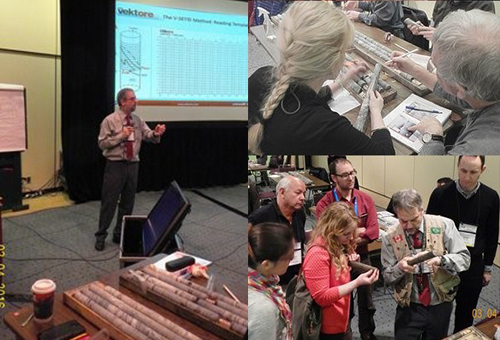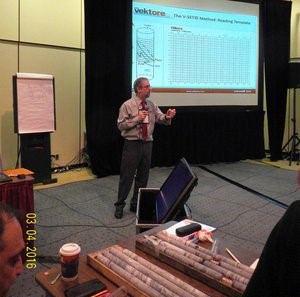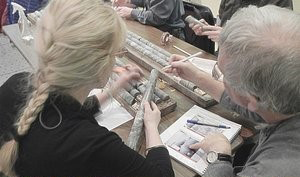Organizer: Rogerio Noal Monteiro, Ph.D. (Vektore Exploration Consulting Corporation) – with the special participation of Mr. Ben Polzer, M.Sc. from Nova Mining Exploration Solutions.
Vektore would like to take this opportunity to thank all attendants of our workshop on Structural Vectoring. It was a pleasure to meet such a multifaceted group of individuals. This multidisciplinary exchange made the course more engaging, and we must say that we also learned also a lot from you. We had a blast showing off our rock collection, and bringing the field and core shack into the PDAC! We also would like to thank Mr.Ben Polzer for showing us his views and experience on how to use the electromagnetic field as a vectoring component in mineral exploration, which merged quite well with the course goals.
Our core objective was to convey the concept of Structural Vectoring to the participants. From basic principles to practical exercises (including structural logging of a core set from a highly complex mineral body), the audience was exposed to a new core logging technique that focuses on identifying and extracting mineralization-related structural features. These features are the building blocks of a mineral body geometry, continuity and spatial orientation, and should be monitored during follow-up drilling (Monteiro, 2015). The Mineralization-related structural features are fundamental geological indicators to be incorporated in mineral resource studies from PEA to Feasibility and beyond.
The audience was exposed to real case mineralization-related structural features and was shown how such features can be efficiently used as predictive tools to direct drilling towards mineral bodies. Strategies on what, why and how many structures should be collected to provide a robust dataset were proposed to the group and debated.
In addition, a new method of collecting structural features from oriented and non-oriented core, the vSET Method© (Monteiro, 2013a) was introduced to the attendants, who had the opportunity to compare its characteristics and strengths with current industry standard methods. The geometry of drilling and its interaction with a mineral body was also discussed and viewed from the Structural Vectoring perspective. In addition, a real case study was presented involving non-oriented core and a significant mineral intersection in which the extension of the mineralization was not realized and properly followed up until the application of the Structural Inversion Method© a new method to build the local geometry of a mineralization space when it is intersected by non-oriented core (Monteiro, 2005 and 2013b).
Below are some of the photos obtained when the PDAC room was transformed into a core shack. We would love to stay in contact with the attendants and any interested party. If you have any further questions or if you are interested in discussing how to improve exploration with the use of Structural Vectoring, please send us an email.



